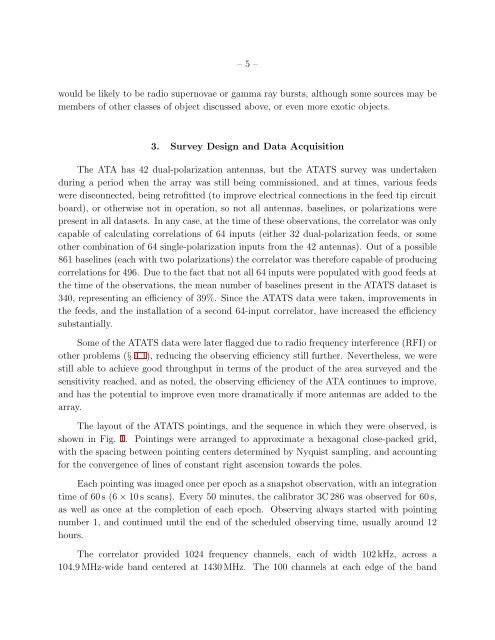The Allen Telescope Array Twenty-centimeter Survey—A - CIRA
The Allen Telescope Array Twenty-centimeter Survey—A - CIRA
The Allen Telescope Array Twenty-centimeter Survey—A - CIRA
Create successful ePaper yourself
Turn your PDF publications into a flip-book with our unique Google optimized e-Paper software.
– 5 –<br />
would be likely to be radio supernovae or gamma ray bursts, although some sources may be<br />
members of other classes of object discussed above, or even more exotic objects.<br />
3. Survey Design and Data Acquisition<br />
<strong>The</strong> ATA has 42 dual-polarization antennas, but the ATATS survey was undertaken<br />
during a period when the array was still being commissioned, and at times, various feeds<br />
were disconnected, being retrofitted (to improve electrical connections in the feed tip circuit<br />
board), or otherwise not in operation, so not all antennas, baselines, or polarizations were<br />
present in all datasets. In any case, at the time of these observations, the correlator was only<br />
capable of calculating correlations of 64 inputs (either 32 dual-polarization feeds, or some<br />
other combination of 64 single-polarization inputs from the 42 antennas). Out of a possible<br />
861 baselines (each with two polarizations) the correlator was therefore capable of producing<br />
correlations for 496. Due to the fact that not all 64 inputs were populated with good feeds at<br />
the time of the observations, the mean number of baselines present in the ATATS dataset is<br />
340, representing an efficiency of 39%. Since the ATATS data were taken, improvements in<br />
the feeds, and the installation of a second 64-input correlator, have increased the efficiency<br />
substantially.<br />
Some of the ATATS data were later flagged due to radio frequency interference (RFI) or<br />
other problems (§ 4.1), reducing the observing efficiency still further. Nevertheless, we were<br />
still able to achieve good throughput in terms of the product of the area surveyed and the<br />
sensitivity reached, and as noted, the observing efficiency of the ATA continues to improve,<br />
and has the potential to improve even more dramatically if more antennas are added to the<br />
array.<br />
<strong>The</strong> layout of the ATATS pointings, and the sequence in which they were observed, is<br />
shown in Fig. 1. Pointings were arranged to approximate a hexagonal close-packed grid,<br />
with the spacing between pointing centers determined by Nyquist sampling, and accounting<br />
for the convergence of lines of constant right ascension towards the poles.<br />
Each pointing was imaged once per epoch as a snapshot observation, with an integration<br />
time of 60s (6×10s scans). Every 50 minutes, the calibrator 3C286 was observed for 60s,<br />
as well as once at the completion of each epoch. Observing always started with pointing<br />
number 1, and continued until the end of the scheduled observing time, usually around 12<br />
hours.<br />
<strong>The</strong> correlator provided 1024 frequency channels, each of width 102kHz, across a<br />
104.9MHz-wide band centered at 1430MHz. <strong>The</strong> 100 channels at each edge of the band



